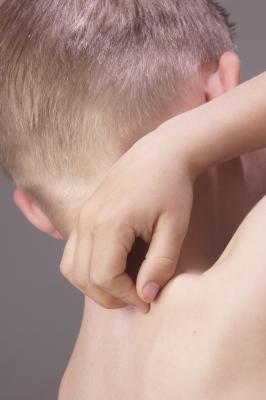Rashes are common during childhood. They can be caused by viruses, bacteria, fungi or allergies. Allergic rashes often occur when the skin comes into contact with something that causes the allergy, such as poison ivy. Allergic rashes can also appear as a result of a food or medication allergy. Luckily, allergic rashes are almost never a serious health threat, according to AskDrSears.com.
Types
There are four main types of allergic rashes, according to the American Academy of Allergy, Asthma and Immunology. The first is atopic dermatitis, which is more commonly known as allergic eczema. Some children are genetically predisposed to eczema and can get it when stressed, overheated or at other times. Other children only suffer from it when it is triggered as an allergic reaction. The second type of allergic rash is hives, and it is the most common rash triggered by allergies. The third type of rash is called angioedema and is less common, but it can be more serious than the first two. Finally, contact dermatitis is the catchall term used for other types of allergic rashes triggered by direct contact with the skin.
Symptoms
Children who suffer from allergic eczema will develop dry, scaly patches of skin that itch. Eczema is most commonly seen behind the elbows and knees, and on the face. Hives are raised, itchy, red areas. They can appear anywhere on the body, but they are most common on the trunk. Angioedema occurs when the deeper layer of skin swells up in an allergic reaction. This type of rash often happens in tandem with hives. The tongue, eyelids, mouth, hands and feet swell up, but they do not itch. Contact dermatitis usually consists of small red bumps that itch and sometimes blister up.
Treatment
Allergic rashes on the skin cannot be cured. In most cases, you simply have to wait until they clear up. You can, however, minimize the itching and pain. Antihistamines can be taken orally to reduce swelling and inflammation. Anti-itch ointments and cool compresses are also effective at reducing redness and pain.
Warning
While allergic rashes themselves are not usually dangerous, they are sometimes accompanied by other, more serious symptoms that indicate a serious allergic reaction. Tightness in the throat (or hives in the mouth and throat), difficulty breathing and prolonged, violent vomiting are all red flags. Seek medical attention immediately.
Considerations
Many other things can also cause rashes other than allergies. Monitor your child carefully when she develops a rash to try to determine what might have caused it. Sometimes it’s easy to tell that it is an allergic reaction, such as if your child eats something and her mouth immediately swells up. Other times, you might be stumped. Note that overheating causes skin rashes in children, as do viruses. Ringworm is a contagious fungus that causes a rash. Some rashes can even be hereditary and are caused by dry, fragile skin rather than an allergy.





